Abstract
In the present work, Fe88Zr8−xSmxB4 (x = 2, 4) amorphous alloys (AAs) were successfully synthesized into the shape of 40-micrometer-thick ribbons and their magnetic properties were measured. The Fe88Zr8−xSmxB4 (x = 2, 4) AAs exhibited a rather high maximum magnetic entropy change (−ΔSmpeak): ~3.53 J/(K × kg) near 317 K for x = 2 and ~3.79 J/(K × kg) near 348 K for x = 4 under 5 T. The effects of a Sm substitution for Zr on the Curie temperature (Tc) and −ΔSmpeak were studied and compared to those of Nd and Pr substitutions, for the purpose of revealing the mechanism involved in more detail.
1. Introduction
With global warming and the increasing population, the demand for air conditioners has increased dramatically in recent years. Conventional vapor compression/expansion refrigeration technology, which is currently the major technology for room-temperature refrigeration, has several disadvantages, such as a low efficiency and environmental unfriendliness. For example, the energy utilization efficiency of traditional refrigeration technology is generally less than 10%, and its refrigerant (freon) is harmful to the ozone layer and leads to holes in the ozone layer, which, in turn, exacerbates global warming [1,2,3,4]. Therefore, it is vitally urgent to improve refrigeration with a novel solution that is not harmful to the environment and has a higher efficiency.
Magnetic refrigeration (MR) technology, using magnetocaloric materials as solid refrigerants, avoids most of the disadvantages of traditional refrigeration technology. For instance, the efficiency of MR technology is much higher and refrigerators that use MR technology are more compact due to the solid refrigerant [3,4,5,6,7]. In addition, MR technology is friendly to the environment because it is free of ozone-depleting gas [6,7]. The application perspective of MR technology depends mainly on the magnetocaloric property of the magnetic refrigerant. The magnetocaloric property, namely the magnetocaloric effect (MCE), is an intrinsic property of magnetic materials that was first observed in iron by E. Warburg in 1881 [8]. The magnetic entropy of a magnet decreases with the ordering of magnetic moments upon magnetization, and increases with demagnetization. The decrease/increase in magnetic entropy under adiabatic conditions leads to the heating/cooling of the magnet, which can be applied to achieve refrigeration.
Magnetocaloric materials can generally be sorted into two categories according to the magnetic phase transition (MPT) that they experience near their Curie temperature (Tc), or the shape of their magnetic entropy change (−ΔSm) curves. Materials undergoing a first-order MPT show a sharp −ΔSm curve, which results in an ultra-high maximum −ΔSm (−ΔSmpeak), but a narrow working temperature range and a low refrigeration capacity (RC) [9,10,11,12,13]. In contrast, second-order MPT materials show a broadened −ΔSm curve that brings about a rather high RC and a wide working temperature range, both of which make second-order MPT materials more suitable to be used as refrigerants in magnetic refrigeration appliances, because a broadened −ΔSm profile is vital for an Ericsson cycle [14,15,16,17,18,19]. As one of the important categories of second-order MPT materials, amorphous alloys (AAs) show unique characteristics that make them more suitable as magnetic refrigerants, such as formability within a wide compositional range and a tunable Tc as a result, better mechanical properties and corrosion resistance than their crystalline counterparts, low eddy current loss due to their high electric resistance, low hysteresis loss due to their excellent soft magnetic properties, and so on [20,21,22]. Amorphous magnetocaloric alloys are generally divided into two groups: rare-earth (RE)-based and transition-metal (TM)-based AAs. RE-based AAs, especially Gd-based AAs, show excellent glass formability (GFA) and outstanding magnetocaloric properties with a rather high −ΔSmpeak at low temperatures [17,19,23,24]. However, the GFA and −ΔSmpeak of these AAs decrease dramatically with their increasing Tc, and thus, Gd-based AAs with a Tc near room temperature exhibit a very low −ΔSmpeak and a poor GFA, which makes them hard to fabricate [25,26,27]. In contrast, TM-based AAs, represented by Fe-based AAs, exhibit a fairly good GFA and can be easily prepared within a wide compositional range, which makes their Tc tailorable within the operating temperature interval of a domestic refrigeration appliance [28,29,30,31,32,33,34,35]. The shortcoming of Fe-based AAs is their low −ΔSmpeak; for example, the −ΔSmpeak under 5 T of Fe-Zr-B ternary glassy alloys is usually not higher than 3.3 J/(K × kg) near room temperature [28,29]. As a consequence, one of the key issues for AAs applied industrially in MR is how to improve the −ΔSmpeak to make it as high as possible near room temperature.
It is well known that microalloying is a useful way to achieve a better GFA and physical properties of AAs. In our preliminary works, we added a small amount of various elements and successfully improved the magnetocaloric performance of the Fe-Zr-B ternary AAs [31,32]. For instance, the −ΔSmpeak under 5 T of Fe88Zr8B4 AAs was enhanced to ~3.42 J/(K × kg) by a minor Co addition and was further improved to ~3.55 J/(K × kg) by a minor Nb addition [31]. A minor Sm substitution for the Fe of Fe88Zr8B4 AAs led to an enhanced −ΔSmpeak up to 3.55 J/(K × kg) [31]. However, microalloying by the substitution of other elements for Fe is finite for the improvement in the −ΔSmpeak.
More recently, we found that the −ΔSmpeak of Fe-Zr-B ternary AAs was further increased by a minor substitution of RE elements for the Zr, and a larger −ΔSmpeak was achieved in the Fe87Ce8B5 AA ribbon (3.65 J/(K × kg) at 282.5 K) [33], Fe88Zr4Pr4B4 glassy ribbon (4.0 J/(K × kg) at 323 K) [34], and Fe88Zr4Nd4B4 glassy ribbon (4.1 J/(K × kg) at 335 K) [35]. The Sm element, with similar characteristics to Pr and Nd, also seemed to be a good substitute for Zr in improving the magnetocaloric performance of Fe-Zr-B AAs. Additionally, the mechanism for the effect of various kinds of RE substitutions on the magnetic and magnetocaloric performance has not been systematically investigated, and an understanding of the magnetocaloric performance of Fe-based AAs with various RE elements is helpful for developing better Fe-based magnetocaloric AAs with a high −ΔSmpeak within the operating temperature interval of a domestic magnetic refrigerator. In the present work, we studied the effect of a Sm substitution for Zr on the GFA and the magnetic and magnetocaloric performance of Fe88Zr8B4 AAs. Based on the experimental results obtained in this work and our previous works, the mechanism for the effect of an RE substitution on the Tc and −ΔSmpeak of an Fe88Zr8B4 basic alloy was investigated in more details.
2. Experimental Procedures
By arc-melting Fe, Zr, and Sm metal blocks (purity > 99.9 at.%) and an Fe-B pre-alloy at least four times, ingots with nominal compositions of Fe88Zr8−xSmxB4 (x = 2, 4) were synthesized in a high-vacuum furnace protected by an Ar atmosphere. Due to the evaporation amount of the Sm element accounting for almost 4.39 wt.% of the total mass of the ingot during the arc-melting process, the actual concentration of Sm in the alloy ingots was estimated to be 1.91 at.% when x = 2 and 3.83 at.% when x = 4. Considering that there was not a significant deviation in the Sm concentration, the nominal composition of the two alloys is still used in the following text. The Fe88Zr8−xSmxB4 (x = 2, 4) ribbons were prepared using a melt-spinning technology at a rotation rate of ~55 m/s. The distance from the nozzle to the wheel was about 2 mm and the melts were ejected onto the wheel surface under an ejection pressure of 0.5 MPa when the alloy melts were flowable. The Fe88Zr8−xSmxB4 (x = 2, 4) as-quenched ribbons with an average thickness of approximately 40 μm were picked for subsequent investigations. The amorphous characteristics of the samples were firstly examined with a PANalytical X-ray diffractometer (XRD, Panalytical, Netherlands) using Cu Kα radiation, and further ascertained using the differential scanning calorimetry (DSC) curves measured using a NETZSCH 404 C calorimeter (Netzsch, Selb, Germany). The thermal properties of the AAs were obtained from the DSC curves measured at a heating rate of 0.333 K/s. A microstructural observation of the Fe88Zr6Sm2B4 amorphous ribbon was performed using a JEOL JEM-F200 cold field emission high-resolution electron microscope (HREM, JEOL, Tokyo, Japan). The HREM sample was polished using a GATAN 691 precision ion-polishing system (Ametek, Berwyn, PA, USA). A vibrating sample magnetometer (VSM) module on a Quantum Design model 6000 physical properties measurement system (PPMS, Quantum Design, San Diego, CA, USA) was employed for the magnetic measurements of the ribbons.
3. Results
3.1. The Structure of the Fe88Zr8−xSmxB4 (x = 0, 2, 4) as-Quenched Ribbons
The XRD patterns of the Fe88Zr8−xSmxB4 (x = 0, 2, 4) as-quenched ribbons are illustrated in Figure 1a. The smooth amorphous diffraction peak near 43 degrees and the invisible crystalline peaks suggested that these ribbons were amorphous. The sharp exothermic crystallization peak followed by the smooth endothermic glass transition hump in these DSC traces of ribbons, as shown in Figure 1b, also ascertained their amorphous characteristics.
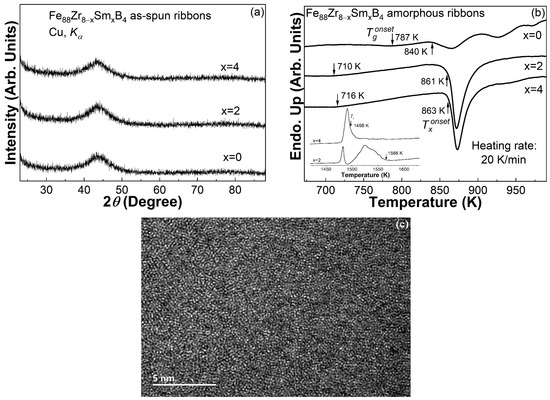
Figure 1.
(a) The XRD patterns of the Fe88Zr8−xSmxB4 (x = 0, 2, 4) as-spun ribbons; (b) the DSC curves of the Fe88Zr8−xSmxB4 (x = 0, 2, 4) amorphous ribbons, with the melting behaviors in the inset; and (c) the HREM image of the Fe88Zr6Sm2B4 amorphous ribbon.
3.2. Thermal Properties and GFA of the Fe88Zr8−xSmxB4 (x = 0, 2, 4) AAs
The thermal properties of the Fe88Zr8−xSmxB4 (x = 2, 4) AAs, including the onset temperature of the glass transition (Tgonset) and primary crystallization (Txonset), were identified, as labeled on the three DSC traces of ribbons in Figure 1b. For comparison, the DSC trace of the Fe88Zr8B4 basic alloy is also shown in Figure 1b. The addition of Sm obviously enlarged the supercooled liquid region (∆Tx = Txonset − Tgonset) [36] of the Fe88Zr8B4 amorphous alloy, which indicated an increased thermal stability against crystallization. The large ∆Tx of ~150 K for the Fe88Zr8−xSmxB4 (x = 2, 4) AAs was much higher than those of the other Fe-Zr-B-based amorphous ribbons listed in Table 1, or even comparable to those of some Zr-based bulk metallic glasses [37]. The liquidus temperatures (Tl) of the Fe88Zr8−xSmxB4 AA ribbons obtained from their melting curves, as displayed in the inset of Figure 1b, were approximately 1566 K for x = 2 and 1498 K for x = 4. Thus, the reduced glass transition temperature (Trg, defined as the ratio of Tgonset to Tl) [38] and the parameter γ (=Txonset/(Tgonset + Tl)) [39] of the Fe88Zr8−xSmxB4 AA ribbons were determined to be 0.453 and 0.378 for x = 2, and 0.478 and 0.390 for x = 4. Although the Trg of the Fe88Zr8−xSmxB4 (x = 2, 4) AAs was not as large as that of the Fe88Zr8B4 alloy (Trg = 0.489) [31], their γ was much larger than that of the Fe88Zr8B4 alloy (γ = 0.350) due to the enlarged supercooled liquid region. Furthermore, the γ values of the Fe88Zr8−xSmxB4 AAs were also much larger than that of other Fe-Zr-B-based AAs, as listed in Table 1, which made the Fe88Zr8−xSmxB4 AAs exhibit a very large theoretical value of critical section thickness (Zc, ~1.96 mm for x = 2 and ~3.24 mm for x = 4) [39], even though the Trg of the Fe88Zr8−xSmxB4 AAs was not high enough. As a result, the large values of ∆Tx, γ, and Zc of the Fe88Zr8−xSmxB4 AAs indicated that they showed a better thermal stability than other Fe-Zr-B-based amorphous ribbons and a sufficient GFA for the preparation of continuous amorphous ribbons.

Table 1.
The thermal parameters ∆Tx, Trg, γ, and Zc of some Fe-Zr-B-based amorphous alloys.
It has been reported that the presence of nanocrystals promotes heterogeneous nucleation during crystallization and weakens the thermal stability of AAs [40], while the XRD and DSC results may not distinguish a small number of small-sized nanoparticles [41]. Therefore, in order to further confirm the amorphous structure of the two ribbons, the Fe88Zr6Sm2B4 amorphous ribbon with a lower GFA was employed for HREM observation. There were no obvious nanoparticles or a long-range order, but only 1~2 nm of a short-range order in the disordered matrix, as shown in Figure 1c, implying a fully amorphous state of the Fe88Zr6Sm2B4 ribbon.
3.3. Magnetic Properties of the Fe88Zr8−xSmxB4 (x = 0, 2, 4) AAs
The magnetization vs. temperature (M-T) curves of the Fe88Zr8−xSmxB4 (x = 0, 2, 4) amorphous ribbons were measured from 200 K to 380 K under 0.03 T after a zero-field-cooling (ZFC) process from 300 K to 200 K, as shown in Figure 2a. Therefore, by taking one derivative of the M-T curves, the Curie temperature of the Fe88Zr8−xSmxB4 AA samples was determined to be 292 K for x = 0, 317 K for x = 2, and 348 K for x = 4. The Sm addition dramatically improved the Tc of the Fe88Zr8B4 AAs.
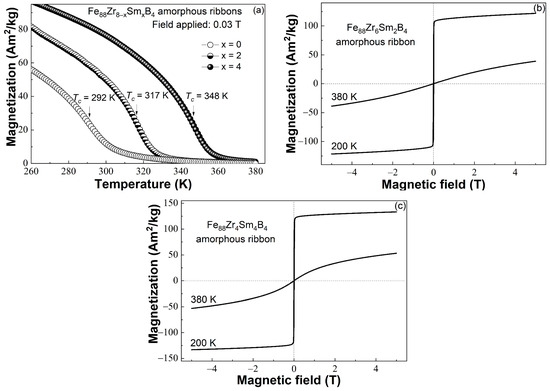
Figure 2.
(a) The M-T curves of the Fe88Zr8−xSmxB4 (x = 0, 2, 4) amorphous ribbons; the hysteresis loops of the (b) Fe88Zr6Sm2B4 and (c) Fe88Zr4Sm4B4 amorphous ribbons measured at 200 K and 380 K under 5 T.
The hysteresis loops of the Fe88Zr8−xSmxB4 (x = 2, 4) AAs measured under 5 T at 200 K and 380 K are illustrated in Figure 2b and Figure 2c, respectively. Both the samples were soft-magnetic at 200 K and paramagnetic at 380 K. The saturation magnetization (Ms) reached 127 Am2/kg for the Fe88Zr6Sm2B4 amorphous sample and 139 Am2/kg for the Fe88Zr4Sm4B4 sample. The saturation magnetization of the Fe88Zr8B4 metallic glass (104 Am2/kg at 200 K [32]) was obviously improved by the Sm substitution, which indicated a better magnetocaloric performance of the Sm-doped samples because both the Ms and the −ΔSmpeak of the amorphous samples depended mainly on their ordering of magnetic moments.
3.4. Magnetocaloric Performance of the Fe88Zr8−xSmxB4 (x = 2, 4) AAs
Magnetic entropy changes in AAs are usually derived from their isothermal magnetization (M-H) curves measured at different temperatures. Figure 3 shows the M-H curves of the (a) Fe88Zr6Sm2B4 and (b) Fe88Zr4Sm4B4 amorphous samples. Thus, we calculated the −ΔSm at different temperatures (−ΔSm-T curve) of the Fe88Zr8−xSmxB4 metallic glasses according to the Maxwell equation [42]. The −ΔSm-T curves of the Fe88Zr8−xSmxB4 ribbons under different applied fields are depicted in Figure 4a,b. The −ΔSmpeak of the two samples under 1 T, 1.5 T, 2 T, 3 T, 4 T, and 5 T are summarized in Table 2. As expected above, the −ΔSmpeak under 5 T reached 3.53 J/(K × kg) near 317 K for the Fe88Zr6Sm2B4 ribbon and 3.79 J/(K × kg) near 348 K for the Fe88Zr4Sm4B4 ribbon, both of which were much higher than those of the Fe88Zr8B4 AA and other Fe-Zr-B-based amorphous ribbons [28,31,32,33]. As a result, the minor Sm substitution for Zr improved the magnetocaloric performance of the Fe88Zr8B4 metallic glass.
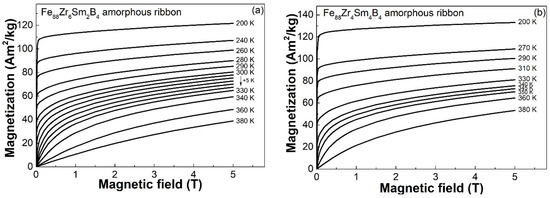
Figure 3.
The isothermal magnetization curves of the (a) Fe88Zr6Sm2B4 and (b) Fe88Zr4Sm4B4 amorphous ribbons at various temperatures ranging from 200 K to 380 K under 5 T.
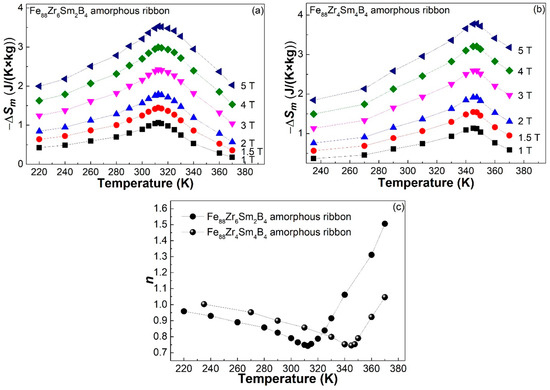
Figure 4.
The −ΔSm-T curves of the (a) Fe88Zr6Sm2B4 and (b) Fe88Zr4Sm4B4 amorphous ribbons under various magnetic fields; (c) the temperature dependence of the exponent n for the Fe88Zr8−xSmxB4 (x = 2, 4) amorphous ribbons.

Table 2.
Tc and −ΔSmpeak of the Fe88Zr8−xRExB4 (RE = Sm, Nd, Pr; x = 0, 2, 4) amorphous alloys.
The magnetocaloric behaviors described by the n-T curves of the Fe88Zr8−xSmxB4 amorphous samples are depicted in Figure 4c, where n is the slope of the linear fit for the ln(−ΔSm) vs. ln (H) plots. The shape of the n-T curves of the Fe88Zr8−xSmxB4 metallic glass ribbons was similar to those of other amorphous alloys [32,43]. The minimum n value was ~0.74 at 312.5 K for the Fe88Zr6Sm2B4 ribbon and ~0.745 at 345 K for the Fe88Zr4Sm4B4 sample, both of which were close to the predicted value of fully amorphous alloys [43].
4. Discussion
4.1. Low-Temperature Magnetic Properties and Their Influence on the Magnetocaloric Properties of Sm-Doped Fe88Zr8B4 AA Amorphous Ribbons
It is argued that the introduction of RE atoms to iron-based amorphous alloys may give rise to an interaction between Fe and the RE atoms, and lead to the formation of randomly oriented anisotropic clusters. The coupling between these anisotropic clusters may result in spin-glass freezing behaviors and large hysteresis at low temperatures [44,45,46], which may be harmful to the magnetocaloric performance of RE-doped Fe-based AAs. Therefore, it is essential to study the low-temperature magnetic properties of Fe-based AAs containing RE elements.
Fortunately, the spin-glass freezing behaviors and hysteresis are usually negligible when the RE concentration is very low because the anisotropic clusters are hard to couple with each other due to the low density of these clusters [34,35]. Therefore, we selected the Fe88Zr4Sm4B4 AA that contained the highest Sm content in the present work to study its low-temperature magnetic properties and their possible effect on the magnetocaloric properties in more detail.
Figure 5 shows the ZFC and field-cooling (FC, field applied: 0.03 T) M-T curves of the Fe88Zr4Sm4B4 AA sample. The ZFC M-T curve of the Fe88Zr4Sm4B4 AA ribbon almost overlapped the FC M-T curve, which implies that there was almost no spin-glass-like behavior in the Fe88Zr4Sm4B4 metallic glass. The hysteresis loop of the ribbon measured at 10 K is shown in the inset of Figure 5. Although the coercivity of the amorphous ribbon slightly increased compared to that of the Fe88Zr8B4 alloy (~4.89 kA/m [32]), its value was only 8.61 kA/m at 10 K; in other words, it was negligible even at 10 K. The invisible spin-glass-like behavior and negligible coercivity at low temperatures indicate that the low-concentration Sm substitution for Zr did not induce an obvious interaction between random anisotropic clusters, and thus, barely affected the magnetocaloric performance of the AA.
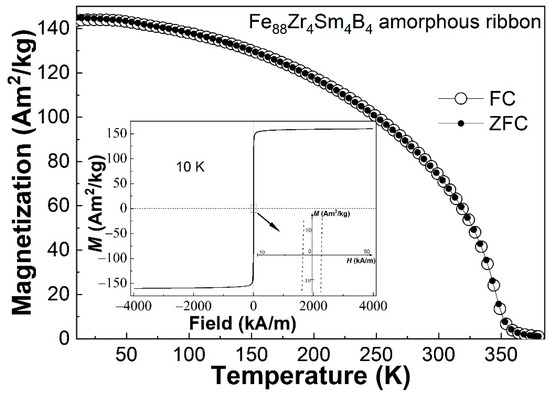
Figure 5.
The ZFC and FC M-T curves of the Fe88Zr4Sm4B4 amorphous ribbon; the inset is the hysteresis loop of the Fe88Zr4Sm4B4 amorphous ribbon at 10 K.
4.2. The Compositional Dependence of Tc in RE-Doped Fe88Zr8B4 AAs
As is known, the tailorable Curie temperature is one of the major characteristics of AAs that are superior to intermetallic alloys. Therefore, it is vitally important to understand the mechanism for the compositional dependence of Tc in these AAs. In the present work, the relationship between Tc and the Sm concentration in the Fe88Zr8−xSmxB4 AAs was observed and compared to the dependence of Tc on the Nd and Pr content in the Fe88Zr8−xRExB4 (RE = Nd, Pr) amorphous alloys. Figure 6a shows the Tc of the Fe88Zr8−xRExB4 (RE = Sm, Nd, Pr; x = 0, 2, 4) amorphous ribbons. The Tc of the samples increased monotonously with the RE addition. The Tc of the Sm-doped AAs increased faster than that of the Nd-doped AAs, and much faster than that of the Pr-doped AAs. Previous works that focused on the compositional dependence of Tc in RE-TM-based AAs revealed that the Tc of these AAs is influenced by the direct TM-TM interaction as well as the indirect RE-RE and RE-TM interactions [47]. Both the direct TM-TM interaction and indirect RE-RE interaction have a similar impact on Tc in the RE-TM-based AAs; that is, Tc changes linearly with the TM concentration or RE concentration. The relationship between the indirect RE-TM interaction and Tc is more complicated and may exhibit an anti-parabolic shape. Fortunately, the negligible random magnetic anisotropy coupling mentioned above and the linear relationship between the Tc and the RE content indicate that the Fe-RE interaction in Fe88Zr8−xRExB4 AAs may be very weak or ignorable due to the low concentration of RE. On the other hand, as the Fe concentration in Fe88Zr8−xRExB4 is fixed, the effect of the direct Fe-Fe interaction on the Curie temperature did not need to be considered in the present work. Therefore, the Tc of the Fe88Zr8−xRExB4 AAs depended mainly on the type of RE and its concentration. According to the Rudermann–Kittel–Kasuya–Yosida (RKKY) indirect interaction model, Tc obeys a linear relationship with the de Gennes factor (G) of the RE in the AAs that contain only one rare earth element, as follows [48]:
where kB is the Boltzman constant and I(0) is the indirect exchange integral. From Figure 6a, one can find that Tc increases linearly with the RE concentration when the kind of RE is fixed, which is related to the linear increase in the indirect exchange integral with the addition of RE. On the other hand, as the G value is 4.44 for Sm, 3.20 for Nd, and 0.80 for Pr, the Tc of the Fe88Zr8−xSmxB4 AAs is expected to be higher than the Tc of the Fe88Zr8−xNdxB4 AAs and much higher than the Tc of the Fe88Zr8−xPrxB4 AAs according to the equation when the RE concentration is fixed. Figure 6b shows the approximately linear dependence of Tc on the G values of Sm, Nd, and Pr when x = 2 and x = 4 of the Fe88Zr8−xRExB4, both of which demonstrated that the Tc of the Fe88Zr8−xRExB4 AAs is determined by the concentration and G value of the RE. The relationship between Tc and the de Gennes factor also implies the effectiveness of the de Gennes factor in determining or adjusting the Tc of RE-containing AAs.
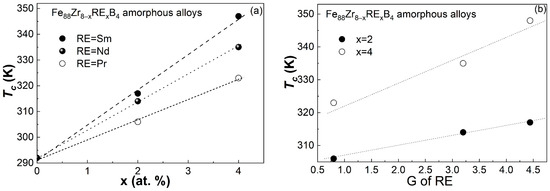
Figure 6.
(a) The compositional dependence of Tc for the Fe88Zr8−xRExB4 (RE = Sm, Nd, Pr; x = 0, 2, 4) amorphous alloys; (b) the relationship between the G values of different RE types and their Tc (solid circles represent x = 2 and hollow circles represent x = 4).
4.3. Magnetocaloric Performance of RE-Doped Fe88Zr8B4 AAs
Figure 7a shows the −ΔSm-T curves under 5 T of the Fe88Zr8−xSmxB4 AA ribbons, and the Fe88Zr8−xNdxB4 as well as the Fe88Zr8−xPrxB4 AAs for comparison purposes. Apparently, the −ΔSmpeak of Fe88Zr8B4 metallic glass was not only improved by a minor Sm substitution, but was also improved by Pr and Nd substitutions for Zr. Table 2 lists the −ΔSmpeak under various magnetic fields of the Fe88Zr8−xRExB4 (RE = Sm, Pr, Nd; x = 0, 2, 4) AAs. One can find that the improvement in the −ΔSmpeak by the minor Sm addition was not as high as that resulting from the Pr and Nd additions at a fixed RE content; for example, the −ΔSmpeak of the Fe88Zr6Sm2B4 amorphous ribbon at 5 T was ~3.53 J/(K × kg) at 317 K, which was lower than that of the Fe88Zr6Pr2B4 AA ribbon (~3.60 J/(K × kg) at 306 K [34]) and the Fe88Zr6Nd2B4 AA ribbon (~3.65 J/(K × kg) at 314 K [35]); the −ΔSmpeak of the Fe88Zr4Sm4B4 amorphous ribbon at 5 T was ~3.79 J/(K × kg) at 348 K, which was lower than that of the Fe88Zr4Pr4B4 AA ribbon (~4.00 J/(K × kg) at 323 K [34]) and much lower than that of the Fe88Zr6Nd2B4 AA ribbon (~4.10 J/(K × kg) at 335 K [35]).
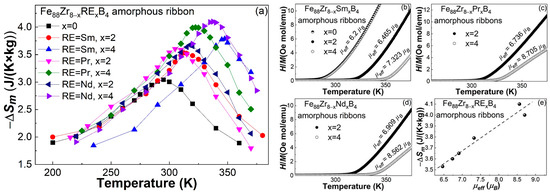
Figure 7.
(a) The −ΔSm-T curves under 5 T of the Fe88Zr8−xRExB4 (RE = Sm, Nd, Pr; x = 0, 2, 4) amorphous ribbons; the effective magnetic moment of the (b) Fe88Zr8−xSmxB4 (x = 0, 2, 4), (c) Fe88Zr8−xPrxB4 (x = 2, 4), and (d) Fe88Zr8−xNdxB4 (x = 2, 4) amorphous alloys; and (e) the relationship between the −ΔSmpeak and µeff of the Fe88Zr8−xRExB4 (RE = Sm, Nd, Pr; x = 2, 4) amorphous alloys.
As the −ΔSm of the AAs depends mainly on the ordering of magnetic moments upon magnetization, an enhancement in −ΔSmpeak by a small amount of RE as a substitution for Zr may be closely related to the extra magnetic moment produced by the introduction of RE atoms. The addition of different kinds or contents of RE elements may result in different −ΔSm improvements in the RE-doped amorphous alloys. As such, we attempted to calculate the effective magnetic moment (µeff) of the Fe88Zr8−xRExB4 AAs from their M-T curves based on the Curie–Weiss law and Langevin function [49]. As shown in Figure 7b–d, the µeff of the Fe88Zr8−xRExB4 amorphous ribbons was ~6.465 µB for RE = Sm and x = 2, ~7.323 µB for RE = Sm and x = 4, ~6.736 µB for RE = Pr and x = 2, ~8.705 µB for RE = Pr and x = 4, ~6.909 µB for RE = Nd and x = 2, and ~8.652 µB for RE = Nd and x = 4. Figure 7e shows the nearly linear relationship between the −ΔSmpeak and the µeff of the Fe88Zr8−xRExB4 AAs, which indicates that the −ΔSmpeak of the minor RE-doped Fe88Zr8B4 metallic glasses was closely related to their effective magnetic moment. Additionally, the µeff of the Fe88Zr8B4 alloy was calculated to be ~6.2 µB, as shown in Figure 7b. It was found that the addition of an RE element obviously enhanced the µeff of the Fe88Zr8B4 alloy. The increased −ΔSmpeak and enhanced µeff suggest that an RE addition has a positive role in the improvement in the −ΔSmpeak of Fe-based AAs.
5. Conclusions
Fe88Zr8−xSmxB4 (x = 2, 4) amorphous samples with an average thickness of ~40 μm were successfully synthesized in this work. The GFA of the Fe88Zr8−xSmxB4 (x = 2, 4) alloys was good enough for the 40-micrometer-thick amorphous ribbons. The effect of a Sm introduction on the magnetic and magnetocaloric performance of the Fe88Zr8B4 AA and the mechanism involved were studied in more detail by comparing with those of other RE additions. The main conclusions are as follows:
- (a)
- The minor Sm-doped Fe88Zr8B4 AAs exhibited typical magnetocaloric behaviors of metallic glasses, and the invisible spin-glass-like behavior and negligible coercivity at low temperatures indicated that the minor Sm addition barely affected the magnetocaloric properties of the AAs.
- (b)
- The Tc of the Fe88Zr8−xSmxB4 AAs increased faster than those of the Fe88Zr8−xPrxB4 and Fe88Zr8−xNdxB4 AAs. The nearly linear relationship between the Tc and the de Gennes factor of Sm, Nd, and Pr when x = 2 and x = 4 demonstrated that the Tc of the Fe88Zr8−xRExB4 AAs was determined by the concentration and G value of the RE.
- (c)
- Although the −ΔSmpeak of the Fe88Zr8B4 AA was improved by the Sm substitution, the −ΔSmpeak of the Fe88Zr8−xSmxB4 was lower than that of the Fe88Zr8−xPrxB4 and Fe88Zr8−xNdxB4 amorphous ribbons when x = 2 and x = 4, respectively. The slightly lower −ΔSmpeak of the Sm-doped AAs was closely related to their lower µeff according to the roughly linear relationship between the −ΔSmpeak and the µeff of the Fe88Zr8−xRExB4 AAs.
In brief, the mechanism of the change in the Tc and −ΔSmpeak of the Fe88Zr8−xRExB4 AAs was revealed, and an RE addition had a positive effect on the magnetocaloric performance of Fe-based AAs. These results are expected to be helpful for achieving excellent magnetocaloric AAs with a high −ΔSmpeak at a tailorable Tc within the operating temperature interval of a domestic magnetic refrigerator.
Author Contributions
Conceptualization, L.X., P.Y. and J.-L.Y.; methodology, D.D.; validation, Q.W. and B.-Z.T.; investigation, Z.-R.Z., X.-J.L. and H.-T.Z.; data curation, Q.W. and D.D.; writing—original draft preparation, Z.-R.Z., X.-J.L. and H.-T.Z.; writing—review and editing, L.X. and Q.W.; funding acquisition, L.X. and P.Y. All authors have read and agreed to the published version of the manuscript.
Funding
This research was funded by the National Natural Science Foundation of China, grant numbers 51871139, 52071196, and 52071043.
Institutional Review Board Statement
Not applicable.
Informed Consent Statement
Not applicable.
Data Availability Statement
Data are contained within the article.
Acknowledgments
This research was technically supported by the Center for Advanced Microanalysis of Shanghai University.
Conflicts of Interest
The authors declare that they have no conflict of interest for this work.
References
- Glanz, J. Making a Bigger Chill with Magnets. Science 1998, 279, 2045. [Google Scholar] [CrossRef]
- Tegus, O.; Bruck, E.; Buschow, K.H.; de Boer, F.R. Transition-metal-based magnetic refrigerants for room-temperature applications. Nature 2002, 415, 150–152. [Google Scholar] [CrossRef]
- Yu, B.F.; Gao, Q.; Zhang, B.; Meng, X.Z.; Chen, Z. Review on research of room temperature magnetic refrigeration. Int. J. Refrig. 2003, 26, 622–636. [Google Scholar] [CrossRef]
- Brück, E. Topical review—Developments in magnetocaloric refrigeration. J. Phys. D Appl. Phys. 2005, 38, R381–R391. [Google Scholar] [CrossRef]
- Franco, V.; Blázquez, J.S.; Ipus, J.J.; Law, J.Y.; Moreno-Ramírez, L.M.; Conde, A. Magnetocaloric effect: From materials research to refrigeration devices. Prog. Mater. Sci. 2018, 93, 112–232. [Google Scholar] [CrossRef]
- Oliveira, N.; Ranke, P. Theoretical aspects of the magnetocaloric effect. Phys. Rep. 2010, 489, 89–159. [Google Scholar] [CrossRef]
- Gschneidner, K.A., Jr.; Pecharsky, V.K.; Tsokol, A.O. Recent developments in magnetocaloric materials. Rep. Prog. Phys. 2005, 68, 1479–1539. [Google Scholar] [CrossRef]
- Warburg, E. Magnetische Untersuchungen. Ann. Phys. 1881, 249, 141–164. [Google Scholar] [CrossRef]
- Pecharsky, V.K.; Gschneidner, K.A., Jr. Giant magnetocaloric effect in Gd5(Si2Ge2). Phys. Rev. Lett. 1997, 78, 4494–4497. [Google Scholar] [CrossRef]
- Shen, B.G.; Sun, J.R.; Hu, F.X.; Zhang, H.W.; Cheng, Z.H. Recent Progress in Exploring Magnetocaloric Materials. Adv. Mater. 2009, 21, 4545–4564. [Google Scholar] [CrossRef]
- Pecharsky, V.K.; Gschneidner, K.A., Jr. Tunable magnetic regenerator alloys with a giant magnetocaloric effect for magnetic refrigeration from ~20 to ~290 K. Appl. Phys. Lett. 1997, 70, 3299–3301. [Google Scholar] [CrossRef]
- Pasquale, M.; Sasso, C.P.; Lewis, L.H.; Giudici, L.; Lograsso, T.; Schlagel, D. Magnetostructural transition and magnetocaloric effect in Ni55Mn20Ga25 single crystals. Phys. Rev. B 2005, 72, 094435. [Google Scholar] [CrossRef]
- Miao, X.F.; Wang, W.Y.; Liang, H.X.; Qian, F.J.; Cong, M.Q.; Zhang, Y.J.; Muhammad, A.; Tian, Z.J.; Xu, F. Printing (Mn,Fe)2(P,Si) magnetocaloric alloys for magnetic refrigeration applications. J. Mater. Sci. 2020, 55, 6660–6668. [Google Scholar] [CrossRef]
- Bouzidi, W.; Mliki, N.; Bessais, L. Second-order magnetic transition and low field magnetocaloric effect in nanocrystalline Pr5Co19 compound. J. Electron. Mater. 2018, 47, 2776–2781. [Google Scholar] [CrossRef]
- Hernández-González, E.L.; Watts, B.E.; Palomares-Sánchez, S.A.; Elizalde Galindo, J.T.; Mirabal-García, M. Second-order magnetic transition in La0.67Ca0.33-xSrxMnO3 (x = 0.05, 0.06, 0.07, 0.08). J. Supercond. Nov. Magn. 2016, 29, 2421–2427. [Google Scholar] [CrossRef]
- Álvarez, P.; Sánchez Llamazares, J.L.; Gorria, P.; Blanco, J.A. Enhanced refrigerant capacity and magnetic entropy flattening using a two-amorphous FeZrB(Cu) composite. Appl. Phys. Lett. 2011, 99, 232501. [Google Scholar] [CrossRef]
- Luo, Q.; Wang, W.H. Magnetocaloric effect in rare earth-based bulk metallic glasses. J. Alloys Compd. 2010, 495, 209–216. [Google Scholar] [CrossRef]
- Hashimoto, T.; Kuzuhara, T.; Sahashi, M.; Inomata, K.; Tomokiyo, A.; Yayama, H. New application of complex magnetic materials to the magnetic refrigerant in an Ericsson magnetic refrigerator. J. Appl. Phys. 1987, 62, 3873. [Google Scholar] [CrossRef]
- Bingham, N.S.; Wang, H.; Qin, F.; Peng, H.X.; Sun, J.F.; Franco, V.; Srikanth, H.; Phan, M.H. Excellent magnetocaloric properties of melt-extracted Gd-based amorphous microwires. Appl. Phys. Lett. 2012, 101, 102407. [Google Scholar] [CrossRef]
- Inoue, A. Bulk amorphous and nanocrystalline alloys with high functional properties. Mater. Sci. Eng. A 2001, 304–306, 1–10. [Google Scholar] [CrossRef]
- Greer, A.L.; Rutherford, K.L.; Hutchings, I.M. Wear resistance of amorphous alloys and related materials. Int. Mater. Rev. 2002, 47, 87–111. [Google Scholar] [CrossRef]
- Liu, X.Y.; Barclay, J.A.; Gopal, R.B.; Földeàki, M.; Chahine, R.; Bose, T.K.; Schurer, P.J.; LaCombe, J.L. Thermomagnetic properties of amorphous rare-earth alloys with Fe, Ni, or Co. J. Appl. Phys. 1996, 79, 1630–1641. [Google Scholar] [CrossRef]
- Xue, L.; Shao, L.L.; Luo, Q.; Shen, B.L. Gd25RE25Co25Al25 (RE = Tb, Dy and Ho) high-entropy glassy alloys with distinct spin-glass behavior and good magnetocaloric effect. J. Alloys Compd. 2019, 790, 633–639. [Google Scholar] [CrossRef]
- Luo, Q.; Zhao, D.Q.; Pan, M.X.; Wang, W.H. Magnetocaloric effect in Gd-based bulk metallic glasses. Appl. Phys. Lett. 2006, 89, 81914. [Google Scholar] [CrossRef]
- Yuan, F.; Li, Q.; Shen, B.L. The effect of Fe/Al ratio on the thermal stability and magnetocaloric effect of Gd55FexAl45-x (x=15–35) glassy ribbons. J. Appl. Phys. 2012, 111, 07A937. [Google Scholar] [CrossRef]
- Zheng, Z.G.; Zhong, X.C.; Su, K.P.; Yu, H.Y.; Liu, Z.W.; Zeng, D.C. Magnetic properties and large magnetocaloric effects in amorphous Gd-Al-Fe alloys for magnetic refrigeration. Sci. China Phys. Mech. Astron. 2011, 54, 1267–1270. [Google Scholar] [CrossRef]
- Liu, G.L.; Zhao, D.Q.; Bai, H.Y.; Wang, W.H.; Pan, M.X. Room temperature table-like magnetocaloric effect in amorphous Gd50Co45Fe5 ribbon. J. Phys. D Appl. Phys. 2016, 49, 055004. [Google Scholar] [CrossRef]
- Yu, P.; Zhang, J.Z.; Xia, L. Effect of boron on the magneto-caloric effect in Fe91-xZr9Bx (x = 3, 4, 5) amorphous alloys. J. Mater. Sci. 2017, 52, 13948–13955. [Google Scholar] [CrossRef]
- Wang, Y.Y.; Bi, X.F. The role of Zr and B in room temperature magnetic entropy change of FeZrB amorphous alloys. Appl. Phys. Lett. 2009, 95, 262501. [Google Scholar] [CrossRef]
- Álvarez, P.; Gorria, P.; Sánchez, M.; Barquín, L.F.; Blanco, J.A. The role of boron on the magneto-caloric effect of FeZrB metallic glasses. Intermetallics 2010, 18, 2464–2467. [Google Scholar] [CrossRef]
- Wu, Y.B.; Wang, Q.; Tang, B.Z.; Pan, L.L.; Ding, D.; Xia, L. Outstanding glass formability and magneto-caloric effect of a Fe85Co3Zr5B4Nb3 metallic glass. J. Non-Cryst. Solids 2021, 566, 120885. [Google Scholar] [CrossRef]
- Zheng, X.N.; Wang, Q.; Yue, C.Y.; Li, A.L.; Ding, D.; Xia, L. Achieving higher magnetic entropy change peak at lower temperature by minor Ti substitution for Zr in the Fe88Zr8B4 metallic glass. Mod. Phys. Lett. B 2023, 37, 2350032. [Google Scholar] [CrossRef]
- Li, A.L.; Wang, Q.; Tang, B.Z.; Yu, P.; Ding, D.; Xia, L. Magnetocaloric effect of the Fe87M8B5 (M = Zr, Ce) amorphous alloys. Mater. Sci. Eng. B Adv. 2022, 286, 116033. [Google Scholar] [CrossRef]
- Wang, Q.; Ding, D.; Tang, B.Z.; Yu, P.; Chan, K.C.; Xia, L. Excellent magnetocaloric performance of a Fe88Zr4Pr4B4 amorphous alloy and its amorphous hybrids. Intermetallics 2023, 161, 107982. [Google Scholar] [CrossRef]
- Wang, P.J.; Wang, Q.; Zheng, S.H.; Zhu, L.Z.; Ding, D.; Tang, B.Z.; Yu, P.; Yao, J.L.; Xia, L. Improvement of Curie temperature and magnetic entropy change of a Fe88Zr8B4 metallic glass by minor Nd substitution. J. Non-Cryst. Solids 2023, 611, 122347. [Google Scholar] [CrossRef]
- Inoue, A. Stabilization of metallic supercooled liquid and bulk amorphous alloys. Acta Mater. 2000, 45, 279–306. [Google Scholar] [CrossRef]
- Zhang, T.; Inoue, A.; Masumoto, T. Amorphous Zr–Al–TM (TM=Co, Ni, Cu) Alloys with Significant Supercooled Liquid Region of Over 100 K. Mater. Trans. JIM 1991, 32, 1005–1010. [Google Scholar] [CrossRef]
- Turnbull, D. Under what conditions can a glass be formed? Contemp. Phys. 1969, 10, 473–488. [Google Scholar] [CrossRef]
- Lu, Z.P.; Liu, C.T. Glass formation criterion for various glass-forming systems. Phys. Rev. Lett. 2003, 91, 115505. [Google Scholar] [CrossRef]
- Minouei, H.; Rizi, M.S.; Akbari, G.H.; Hong, S.I. Effect of residual nanocrystals on thermal stability and mechanical properties of metalloid-containing amorphous alloys. Mater. Charact. 2021, 173, 110914. [Google Scholar] [CrossRef]
- Wang, C.H.; Wang, Q.; Tang, B.Z.; Zhou, X.; Ding, D.; Xia, L. Achieve good magneto-caloric response near the ambient temperature in a Fe86La7B5Ce2 amorphous ribbon. J. Magn. Magn. Mater. 2022, 547, 168954. [Google Scholar] [CrossRef]
- Hashimoto, T.; Numasawa, T.; Shino, M.; Okada, T. Magnetic refrigeration in the temperature range from 10 K to room temperature: The ferromagnetic refrigerants. Cryogenics 1981, 21, 647–653. [Google Scholar] [CrossRef]
- Franco, V.; Blázquez, J.S.; Conde, A. Field dependence of the magnetocaloric effect in materials with a second order phase transition: A master curve for the magnetic entropy change. Appl. Phys. Lett. 2006, 88, 222512. [Google Scholar] [CrossRef]
- Du, J.; Zheng, Q.; Brück, E.; Buschow, K.H.J.; Cui, W.B.; Feng, W.J.; Zhang, Z.D. Spin-glass behavior and magnetocaloric effect in Tb-based bulk metallic glass. J. Magn. Magn. Mater. 2009, 321, 413–417. [Google Scholar] [CrossRef]
- Luo, Q.; Schwarz, B.; Mattern, N.; Eckert, J. Irreversible and reversible magnetic entropy change in a Dy-based bulk metallic glass. Intermetallics 2012, 30, 76–79. [Google Scholar] [CrossRef]
- Luo, Q.; Schwarz, B.; Mattern, N.; Eckert, J. Giant irreversible positive to large reversible negative magnetic entropy change evolution in Tb-based bulk metallic glass. Phys. Rev. B 2010, 82, 024204. [Google Scholar] [CrossRef]
- Zhang, H.Y.; Tan, J.; Zhang, X.; Yan, J.Z.; Shi, H.; Zhu, Y.; Cheng, W.Z.; Li, H.L.; Li, W.H.; Xia, A.L. Correlation between Magnetocaloric Properties and Magnetic Exchange Interaction in Gd54Fe36B10-xSix Amorphous Alloys. Materials 2023, 16, 3629. [Google Scholar] [CrossRef]
- Zhang, H.Y.; Li, R.; Zhang, L.L.; Zhang, T. Tunable magnetic and magnetocaloric properties in heavy rare-earth based metallic glasses through the substitution of similar elements. J. Appl. Phys. 2014, 115, 133903. [Google Scholar] [CrossRef]
- Matsumoto, N.; Shimosaka, T. Validation of a quantitative analytical method based on the effective magnetic moment and the Curie–Weiss law. Accred. Qual. Assur. 2015, 20, 115–124. [Google Scholar] [CrossRef]
Disclaimer/Publisher’s Note: The statements, opinions and data contained in all publications are solely those of the individual author(s) and contributor(s) and not of MDPI and/or the editor(s). MDPI and/or the editor(s) disclaim responsibility for any injury to people or property resulting from any ideas, methods, instructions or products referred to in the content. |
© 2023 by the authors. Licensee MDPI, Basel, Switzerland. This article is an open access article distributed under the terms and conditions of the Creative Commons Attribution (CC BY) license (https://creativecommons.org/licenses/by/4.0/).